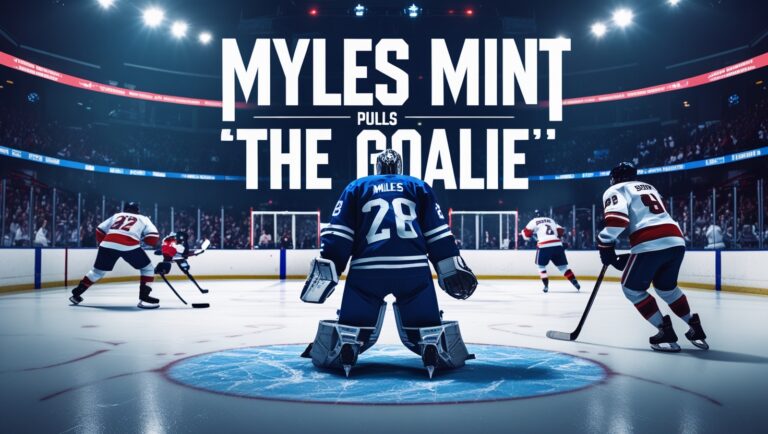In hockey, myles mint pulls the goalie and quick decision-making are key to success. One of the most intense and dramatic moments in a hockey game occurs when the coach decides to pull the goalie. For fans and players alike, this move can bring excitement and, in some cases, heartbreak. In this article, we will delve into the strategy behind pulling the goalie, with a particular focus on Myles Mint’s approach to this high-risk, high-reward decision. We’ll explore the reasoning behind this move, its implications for the game, and how it affects the dynamics of a match.
Understanding the Role of the Goalie in Hockey
Before we dive into the specific decisions made by Myles Mint, it’s important to understand the crucial role the goalie plays in a hockey game. The goalie is arguably the most important player on the ice. Their primary role is to prevent the opposing team from scoring by blocking pucks and protecting the net. Goaltenders are typically seen as the last line of defense, and a good goalie can be the difference between victory and defeat.
When is the Goalie Pulled?
Pulling the goalie is a tactic used by teams, typically when they are trailing in the game and need an extra player on the ice to create scoring opportunities. By pulling the goalie, the team effectively sacrifices defense for offense. It is a gamble that requires precise timing and the right circumstances. The most common time for a goalie to be pulled is during the final moments of the game when the team is behind by one or two goals.
However, pulling the goalie too early can leave a team vulnerable to an empty-net goal, while waiting too long can result in a missed opportunity to tie the game. The decision to pull the goalie is influenced by factors such as the score, time remaining, and the team’s offensive and defensive capabilities.
Myles Mint: A Coach Who Knows When to Pull the Goalie
Myles Mint, a coach known for his unconventional strategies, has gained attention for his approach to pulling the goalie. Mint’s decision-making process is deeply rooted in his understanding of the game, as well as his ability to read the flow of the match. While many coaches may opt to pull their goalie in the final minute, Mint is known for making this move earlier in the game under specific circumstances.
A Calculated Risk
Myles Mint does not pull the goalie randomly or without careful consideration. He looks for a specific set of conditions to be met before making the decision. These conditions include:
-
The offensive momentum of the team: If the team has been creating scoring chances and has the puck in the opponent’s zone, Mint may pull the goalie even if there are several minutes left on the clock.
-
The opponent’s defensive weaknesses: If the opposing team has been struggling defensively or is prone to mistakes, pulling the goalie earlier might catch them off guard.
-
The time remaining in the game: Mint evaluates the clock closely. While most coaches will pull the goalie when there are just 1-2 minutes left, Mint might pull the goalie earlier if he believes his team is close to scoring but needs a little more offensive firepower.
Analyzing Myles Mint’s Game-Tactics
Myles Mint’s approach to pulling the goalie is a well-thought-out strategy that has yielded both successes and failures. Let’s take a look at some specific examples of how he has used this strategy in past games.
The “Early Pull” Against the Rivals
In one memorable game, Mint’s team found themselves down by one goal with just under 5 minutes left in the third period. Most coaches would have waited until the final minute or two to pull the goalie, but Mint’s team had been applying heavy pressure on the opponent’s defense. Mint decided to pull the goalie early, giving his team a 6-on-5 advantage.
Despite the risks, Mint’s move paid off. Within a minute of pulling the goalie, his team scored the game-tying goal. They went on to win in overtime, thanks in part to the extra offensive player on the ice.
The “Desperation Move” in the Playoffs
In a playoff series against a fierce rival, Mint’s team was down by two goals with only 3 minutes left. Realizing that a comeback was unlikely with just a traditional 5-on-5 lineup, Mint pulled his goalie with just over 3 minutes remaining. The bold decision sent shockwaves through the arena.
While his team didn’t score immediately, Mint’s gamble created several high-quality chances. Ultimately, his team scored once, and then again with less than 30 seconds remaining, sending the game into overtime. They won the game and eventually the series, demonstrating the power of the coach’s daring decision.
The Psychology Behind the Decision
Pulling the myles mint pulls the goalie has a psychological effect on both the team and the opposition. For the team that is pulling the goalie, it sends a message of urgency and a commitment to win at all costs. It forces the players to focus entirely on offense, knowing that they cannot afford any more mistakes.
On the other hand, pulling the goalie puts immense pressure on the opposing team. They now have to defend against an extra attacker, and the threat of an empty-net goal looms large. For many teams, defending against a pulled goalie can be nerve-wracking, especially if they are already under pressure.
The Risks and Rewards of Pulling the Goalie Early
While pulling the goalie can be an effective tactic, it is not without risks. Let’s explore both the potential rewards and the dangers associated with this strategy.
Potential Rewards
-
Increased Offensive Power: With an extra skater on the ice, the team has a better chance of creating scoring opportunities. This can be especially effective if the team has been dominating the offensive zone but has been unlucky in scoring.
-
Surprise Element: An early myles mint pulls the goalie can catch the opposing team off guard, especially if it is done when they least expect it. This element of surprise can lead to defensive mistakes or breakdowns that the team can exploit.
-
Momentum Shift: If the team is able to score quickly after pulling the goalie, it can create a huge momentum shift that can lead to further goals and even a potential comeback.
The Risks
-
Empty Net Goals: The most obvious risk of pulling the goalie is the threat of the opposing team scoring an empty-net goal. If the other team takes advantage of the open net, it can seal the game and leave the team that pulled their goalie with little time to recover.
-
Loss of Defensive Stability: By removing the goalie, the team sacrifices one of their most reliable forms of defense. If the opposing team gains possession of the puck, the team is left vulnerable.
-
Failed Opportunities: In some cases, the move can backfire. If the team does not score while the goalie is pulled, the game could end with no chance for a comeback, and the team might be left feeling deflated.
Conclusion: Is Pulling the Goalie Always the Right Move?
myles mint pulls the goalie approach to pulling the goalie demonstrates that hockey is not just about physical skill; it’s also about understanding strategy, timing, and psychology. While his strategy is not without risks, it highlights the importance of making bold decisions and being willing to take calculated risks. The decision to pull the goalie is a moment of high drama in any game, and when executed with precision, it can be the difference between a heart-stopping victory and a crushing defeat.
Ultimately, pulling the goalie is a tool that coaches can use to tilt the odds in their favor, but it’s a decision that requires careful thought. For Myles Mint, it is not about simply following the conventional wisdom but about trusting his players, understanding the dynamics of the game, and knowing when to take the shot at victory. Whether it’s in the final seconds or with several minutes to go, pulling the goalie remains one of the most exciting and unpredictable strategies in hockey.

